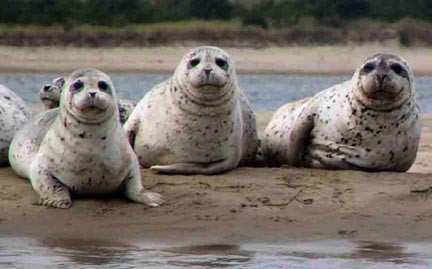abfrontal: The surface of an organ or structure which faces away from the front or is on the opposite side from the surface designated as frontal.
aboral: The side or end that is furthest from the mouth.
adductor: Muscle in bivalve mollusks which runs transversely from one valve (shell) to the other.
afferent: Conducting inwards or towards something. Opposite of efferent.
ambulacrum: In an echinoderm, each of the radially arranged bands, together with their underlying structures, through which the double rows of tube feet protrude.
ampulla: Muscular bulblike internal end of a tube foot in the echinoderms.
anaerobic: Relating to or requiring an absence of free oxygen.
antennae: A pair of long, thin sensory appendages on the heads of in some arthropods.
athecate: without a hydrotheca, the chitinous covering of certain hydrozoans.
atrial: Referring to the atrium, a large chamber containing the pharynx in tuncates. The atrial siphon is the outlet siphon from the atrium.
auricularia: A free-swimming bilaterally symmetrical ciliated larva of holothuroidean echinoderms - sea cucumbers.
bioavailability: The proportion of a substance which enters the body and can have an active effect.
bioluminescence: The biochemical emission of light by living organisms.
buccal: Relating to the mouth. The buccal or oral siphon of a tunicate; the outlet siphon from the atrium.
byssal: Referring to a tuft of tough filaments (the byssus) by which mussels and some other bivalves adhere to rocks and other objects.
capitulum: A compact head of a structure.
carapace: A dorsal and lateral plate covering the cephalothorax - the fused head and thorax - of many crustaceans.
cerata: The external gills of certain nudibranchs; variously shaped.
cheliped: One of the first pair of legs in decapod crustaceans, specialized for seizing and crushing.
chemoreception: The response to chemical stimuli by a sensory organ; taste and smell.
chitin: A fibrous substance consisting of polysaccharides, which is the major constituent in the exoskeleton of arthropods and the cell walls of fungi.
chlorocruorin: A green iron-containing respiratory pigment dissolved in blood plasma of certain polychaetes. It is green when oxygenated, brownish-red when deoxygenated.
choanocyte: A flagellated cell with a collar of protoplasm at the base of the flagellum, numbers of which line the internal chambers of sponges.
chondrophore: A small calcareous shelf, ridge, or tooth to, which a ligament is attached in a bivalve mollusk.
cilium: A short microscopic hair-like vibrating structure found in large numbers (cilia) on the surface of certain cells, either causing currents in the surrounding fluid. They provide propulsion in some microscopic animals.
cirrus: A slender tendril or hair-like filament, such as the appendage of a barnacle. A slender sensory projection on the parapodium or another part of a polychaete.
clone: An organism or cell, or group of organisms or cells, produced asexually from one ancestor or stock, to which they are genetically identical.
commensal: living on another animal or plant and getting food from the situation, but doing no harm
crystalline style: A long, transparent mucoid rod in various mollusks, especially bivalves, that projects from a sac into the stomach, where it rotates against the gastric shield, abrades, and gradually dissolves providing carbohydrate- digesting enzymes.
ctene: A closely adhered group of thousands of cilia that form a paddle-like structure in ctenophores (comb jellies). Rows of ctenes beat in a rhythmic and coordinated pattern to propel the animal.
cydippid: A free-swimming larva of a ctenophore. It resembles an adult.
cyphonaute: Ciliated, conical free-swimming larva of a bryozoan; it has a complete digestive tract.
cypris: An advanced -free-swimming larva of a barnacle. It settles and attaches to a substrate.
dactylozooid: A zooid is an animal arising from another by budding or division, especially when each of the individuals that make up a colonial organism have different forms and functions. The specialized function of a dactylozooid is tactile, sensing touch.
denticle: A small tooth or toothlike projection.
detritus: Organic matter produced by the decomposition of organisms.
digestive cecum: A pouch connected to the digestive tract (pl. ceca).
dioecious: Having the male and female reproductive organs in separate individuals.
doliolaria: The larval stage of sea cucumbers immediately following the auricularia stage. It is cylindrical in shape and possesses five transverse bands of cilia.
efferent: Conducting outwards or from something. Opposite of afferent.
elytra: Dorsal plates or scales on a scale worm polychaete (sing. electrum).
endocuticle: The inner of the two layers of a crustacean exoskeleton cuticle.
ephyra: A larval jellyfish, after separation from the scyphistoma.
epibenthic: Referring to the flora and fauna (epibenthose) living on the surface of the bottom of a sea or lake.
epibiont: An organism that lives on the surface of another organism.
epidermis: The surface epithelium of the skin, overlying the dermis.
epigamy: A form of sexual selection based on the alteration of appearance in some way that provides greater attraction.
epitoky: A process that results in the posterior part of a marine polychaete to become swollen with developing gonads, ova, and sperm during its breeding season (an epitoke).
euryhaline: Able to tolerate a wide range of salinity.
eurythermal: Able to tolerate a wide range of temperature.
exocuticle: The outer of the two layers of a crustacean exoskeleton cuticle.
exoskeleton: A rigid external covering for the body in some invertebrate animals, especially arthropods.
gastrozooid: A zooid is an animal arising from another by budding or division, especially when each of the individuals that make up a colonial organism have different forms and functions. The specialized function of a gastrozooid is feeding.
gonozooid: A zooid is an animal arising from another by budding or division, especially when each of the individuals that make up a colonial organism have different forms and functions. The specialized function of a gonozooid is reproduction.
gonophores: a reproductive structure containing gonads.
hemocoel: The primary body cavity of most invertebrates, containing circulatory fluid.
hemocyte: A cell of the hemolymph of various invertebrates, especially arthropods.
hemolymph: A fluid equivalent to blood in most invertebrates, occupying the hemocoel.
hermaphroditic: An animal having both male and female sex organs or other sexual characteristics.
heteronereid: A free-swimming dimorphic sexual individual of certain polychaete worms (family Nereidae) characterized by greatly enlarged eyes, enlarged and modified parapodia and other appendages, and obliteration of the internal viscera by masses of developing germ cells.
hydranth: A feeding polyp, usually with a mouth and tentacles.
hydrocoral: any colonial marine animal of the hydrozoan order Anthoathecata having a calcareous skeleton resembling that of the true corals.
hydrotheca: A thin translucent vase-like exoskeleton surrounding the feeding polyp of certain hydrozoans.
imaginal disks: This is a term usually associated with insects. In the case of nemerteans, it is referring to development inside the free-swimming pilidium larva and a series of epidermal invaginations that grow around the larval gut. The development culminates in catastrophic metamorphosis, in which the larval body is consumed by the juvenile worm.
labial palps: Two fleshy palps (appendages) on either side of the mouth in bivalve mollusks that separate indigestible and edible material.
lamellae: Thin layers, membranes, or plates of tissue. Layers of gill tissue in a bivalve mollusk and some decapod crustaceans are called lamellae.
lophophore: A structure in certain small marine invertebrates, having the shape of a horseshoe and bearing ciliated tentacles around the mouth.
madroporite: A small sieve-like porous plate on the surface of many echinoderms through which fluid passes back and forth between the surrounding seawater and the internal water vascular system (sometime called a sieve plate).
manca larva: The manca (pl: mancae) is the post-larval juvenile in some crustaceans that resembles a small adult.
mantle: A soft extension or the outer layer of the body wall of mollusks (and brachiopods) that secretes the shell. Its edges are folded, and the space between the folds and the body proper is the mantle cavity.
maxilliped: An appendage modified for feeding, situated in pairs behind the maxillae (a pair of mouthparts used in chewing) in crustaceans.
medusoid: Relating to or denoting the medusa phase in the life cycle of a cnidarian.
medusa: A free-swimming sexual form of a cnidarian such as a jellyfish, typically with an umbrella-shaped body with stinging tentacles around the edge. In some species, medusae are a phase in the life cycle which alternates with a polypoid phase (polyp stage in the life cycle of a cnidarian).
metazoan: A multicellular animal.
microvilli: Many microscopic projections from the surface of some cells.
monomorphic: Existing in only one form. In the case of ctenophores, they have no polyp-like form as do cnidarians.
mysid: A crustacean of an order (Mysida) that comprises the opossum shrimps.
nauplius: The first larval stage of many crustaceans, having an unsegmented body and a single eye.
nematocyst: A specialized cell in the tentacles of a jellyfish or other cnidarians, containing a barbed or venomous coiled thread that can be projected in self-defense or to capture prey.
notochord: A cartilaginous skeletal rod supporting the body in all embryonic and some adult chordate animals.
notopodium: The upper or dorsal branch of a parapodium.
omnivorous: Feeding on a variety of food of both plant and animal origin.
operculum: A structure that closes or covers an aperture; for example, A secreted plate that closes the aperture of a gastropod mollusk's shell when the animal is retracted.
oral: Relating to the mouth.
osculum: A large aperture in a sponge through which water is expelled.
osmoregulation: The maintenance of constant osmotic pressure in the fluids of an organism by the control of water and salt concentrations.
ossicle: A small piece of calcified material forming part of the skeleton of an invertebrate animal such as an echinoderm.
ostium: Any small opening to a chamber in an animal; one of many small openings on the surface of a sponge (pl. ostia).
pallial: Relating to the pallium or mantle of a mollusk or brachiopod. A pallial line ion a bivalve shell is the location of mantle attachment. A pallial sinus is an indentation of the pallial line at the location of the afferent (incurrent) siphon.
palp: A fleshy tapered sensory projection at the anterior end of a polychaete, usually in pairs.
papilla: A small rounded protuberance on a part or organ of the body (pl. papillae).
parapodium: Each of many paired muscular bristle-bearing appendages used in locomotion, sensation, or respiration in a polychaete worm.
pedicellaria: A defensive organ like a minute pincer present in large numbers on an echinoderm.
pelagic: Relating to the open sea.
periostracum: The outer horny or fibrous organic covering of the shell of a mollusk or brachiopod, often brownish in color like varnish.
peristomium: The first true somite (segment) of certain annelids (such as polychaetes), bearing the mouth.
pharynx: The part of the alimentary canal immediately behind the mouth in invertebrates.
phytoplankton: Plankton consisting of microscopic plants.
pilidium: The early, free-swimming, cap-shaped larva of some nemertean worms.
pinnule: A secondary division of a pinnate (feather-like) structure; the secondary branch of a sabellid polychaete radiole (gill).
planula: A free-swimming cndarian larva with a flattened, ciliated, solid body.
pleopod: A forked swimming limb of a crustacean, five pairs of which are typically attached to the abdomen. Also called swimmeret.
pleotelson: The last segment of the pleon (segments with pleopods) of an isopod.
polymorphism: The occurrence of different forms among the members of a population or colony, or in the life cycle of an individual organism.
polyp: A solitary or colonial sedentary form of a cnidarian such as a sea anemone, typically having a columnar body with the mouth uppermost surrounded by a ring of tentacles. Some may be specialized for reproduction. In some species, polyps are a phase in the life cycle which alternates with a medusoid phase.
proboscis: An extensible tubular sucking or defensive organ in some worms and other invertebrates.
propodus: The sixth or penultimate joint of a leg (as a walking leg) of a crustacean (as a decapod) (=propodite).
prostomium: In various invertebrates: a part of the body situated in front of or anterior to the mouth; especially (in annelid worms) the lobe or region anterior to the mouth (and to the first metameric segment), which in polychaetes contains the brain and bears eyes and sensory appendages.
protandrous: Having the male reproductive organs come to maturity before the female.
rachis: The midrib of a pinnately compound structure, as the shaft of a feather.
radiole: In a feather duster worm or other tentaculate marine worm: each of the main branches or filaments in the branchial crown.
radula: a structure in mollusks bearing tiny teeth used for scraping food particles off a surface and drawing them into the mouth
respiratory trees: In sea cucumbers, either of two thin-walled, highly branched organs that draw in oxygenated sea water from the cloaca and extend into the fluid-filled body cavity.
rhinophore: In opisthobranch molluscs, such as nudibranchs, each of a pair of stout, often retractile tentacles located at the back of the head (posterior to the oral or cephalic tentacles) and having a chemosensory function.
rostrum: A beaklike projection, especially a stiff snout or anterior prolongation of the head in an insect, crustacean, or cetacean.
schizogamy: Reproduction resulting in the division of an animal, as a polychaete, into a sexual and asexual individual.
scutum: One of a pair of calcareous plates, along with terga, that close the opening of a barnacle (pl. scuta).
scyphistoma: The fixed polyp-like stage in the life cycle of a jelly (jellyfish), which reproduces asexually by budding (strobilation).
sessile: Fixed in one place; immobile.
setae: A stiff structure resembling a hair or a bristle, especially in an invertebrate.
siphon: A tubular organ in an aquatic animal, especially a mollusk, through which water is drawn in or expelled.
spicules: Each of the small needle-like or sharp-pointed structures of calcite or silica that make up the skeleton of a sponge.
stolons: The branched stem-like structure of some colonial hydroids, attaching the colony to the substrate. (See the definition as it applies to seaweeds and vascular plants).
strobila: A stack of immature larval jellies (jellyfish) formed on a sessile polyp-like form by budding, the scyphistoma stage of some jellies.
strobilization: The process of reproducing from a strobila.
stylet: A needle-shaped piercing structure usually associated with the mouth and used for feeding and/or defense; found at the tip of the proboscis in nemerteans.
supralittoral: Situated immediately above the limit of high tides; specifically designating an ecological zone extending from mean high tide to the limit of the influence of sea spray.
symbiosis: Interaction between two different organisms living in close physical association, typically to the advantage of both.
tentillum: A branch of a tentacle, in this case a branch off a main tentacle of the Sea Gooseberry (pl. tentilla).
tergum: One of a pair of calcareous plates, along with scuta, that close the opening of a barnacle (pl. terga).
terpenoid: Any of a large class of organic compounds including terpenes, diterpenes, and sesquiterpenes. They have unsaturated molecules composed of linked isoprene units, generally having the formula (C₅H₈)n.
test: a rigid calcareous skeleton of echinoid echinoderms, e.g., sand dollars and sea urchins.
tetrodotoxin: A powerful neurotoxin.
trochophore: The planktonic larva of certain invertebrates, including some mollusks and polychaete worms, having a roughly spherical body, a band of cilia, and a spinning motion.
tubercle: A small rounded projection or protuberance.
tunic: The rubbery outer coat of a sea squirt.
umbo: The highest point of each valve of a bivalve shell.
valves: Each of the halves of the hinged shell of a bivalve mollus or brachiopod, the plates of a chiton, or of the parts of the compound shell of a barnacle.
veliger: The final larval stage of certain mollusks, having two ciliated flaps for swimming and feeding.
verrucae: A vertical row of white spots resembling warts on the column of some anemones.
zoea: A larval stage of crabs characterized by long anterior and dorsal spines.
zoecium: The calcified layer of bryozoans in the orders Cheilostomata and Cyclostomata that forms a box-like house that contains the soft inner organs and lophophore of a zooid.
zoochlorellae: Any of various unicellular green algae (genus Chlorella) which are symbionts within the cells of certain freshwater and marine invertebrates and protists.
zooid: An animal arising from another by budding or division, especially each of the individuals which make up a colonial organism and typically have different forms and functions.
zooxanthellae: A yellowish-brown symbiotic dinoflagellate present in large numbers in the cytoplasm of many marine invertebrates.
zygote: A diploid cell resulting from the fusion of two haploid gametes; a fertilized ovum (fertilized egg).



